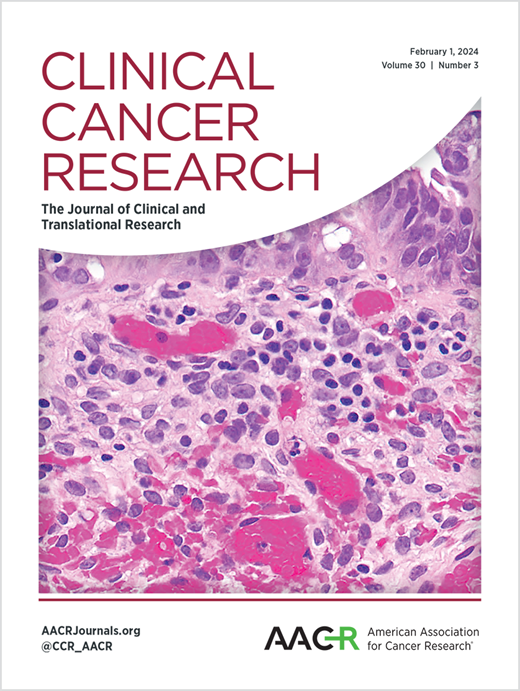Radiation Dose-Volume Effects on Negative Tumor-Draining Lymph Nodes Impacted T-Cell Activation and Prognosis in Esophageal Cancer with Chemoradiotherapy
IF 10
1区 医学
Q1 ONCOLOGY
引用次数: 0
Abstract
Purpose: Preclinical model found that elective nodal irradiation (ENI) attenuated the efficacy of radiotherapy and radio-immunotherapy. However, limited clinical studies have explored the correlation between radiation dose-volume parameters of negative tumor draining lymph nodes (TDLNs) and T-cell activation/prognosis for cancer patients treated with definitive radio(chemo)therapy. Experimental Design: Patients with locally advanced esophageal cancer undergoing definitive chemoradiotherapy (CRT) were selected from two prospective trials. Dose-volume parameters of TDLN as well as other lymphocyte-related organs at risk (LOARs) and lymphocyte subsets such as CD3-CD19+ B cells, CD8+CD28+ T cells, and activated T cells (CD3+CD8+HLA-DR+) before and at the end of radiotherapy (RT) were collected. Logistic analysis was utilized to correlate dose-volume parameters with reductions in lymphocyte subsets. Prognosis of TDLN irradiation was investigated through Kaplan-Meier analysis and Cox hazards models. Results: Among 512 patients, the median mean dose of TDLN and negative non-TDLN was 25.6 Gy and 15.1 Gy, respectively. Multivariable analyses indicated TDLN V15 >50% was an independent predictor of poorer local-recurrence free survival (HR, 1.31; p=0.029) and distant-metastasis free survival (HR, 1.39; p<0.001), as well as greater reductions in CD3-CD19+ B cells (OR, 1.98; p=0.002), CD8+CD28+ T cells (OR, 3.42; p<0.001) and CD3+CD8+HLA-DR+ T cells (OR, 4.67; p=0.002) post-RT. Conclusions: A higher radiation dose-volume parameter of TDLNs in esophageal cancer patients undergoing CRT was significantly associated with suppression of T-cell activation and a worse prognosis. Limiting the percentage of TDLN V15 may be beneficial for improving the prognosis of CRT with or without PD-1 inhibitors.求助全文
约1分钟内获得全文
求助全文
来源期刊

Clinical Cancer Research
医学-肿瘤学
CiteScore
20.10
自引率
1.70%
发文量
1207
审稿时长
2.1 months
期刊介绍:
Clinical Cancer Research is a journal focusing on groundbreaking research in cancer, specifically in the areas where the laboratory and the clinic intersect. Our primary interest lies in clinical trials that investigate novel treatments, accompanied by research on pharmacology, molecular alterations, and biomarkers that can predict response or resistance to these treatments. Furthermore, we prioritize laboratory and animal studies that explore new drugs and targeted agents with the potential to advance to clinical trials. We also encourage research on targetable mechanisms of cancer development, progression, and metastasis.
 求助内容:
求助内容: 应助结果提醒方式:
应助结果提醒方式:


